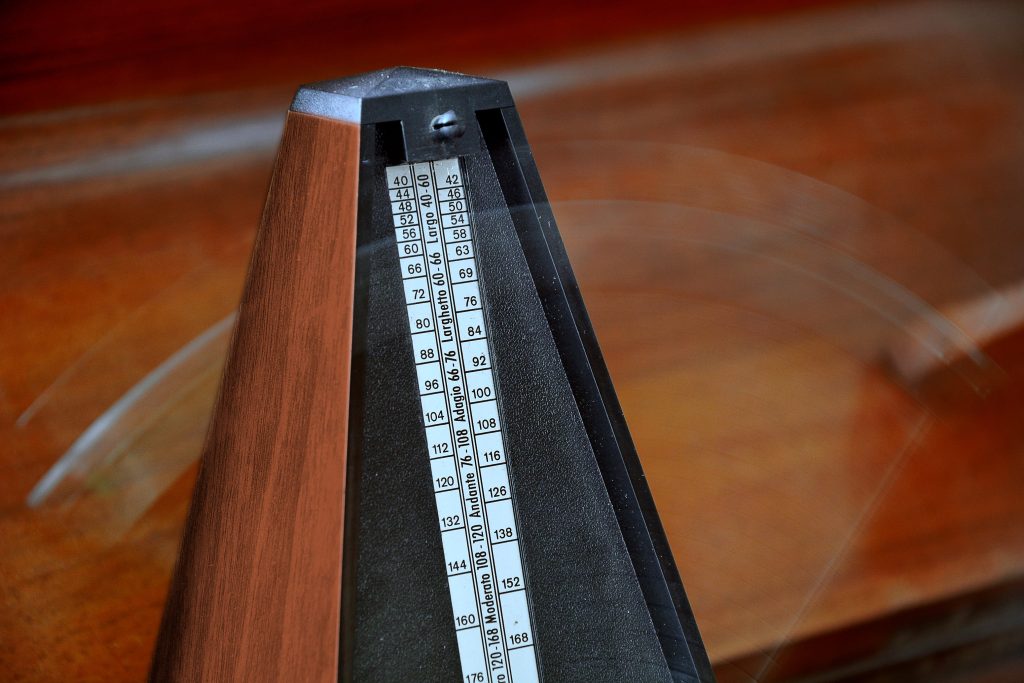How to improve bass guitar timing
It’s a basic aspect of our craft that can make or break a performance. In this comprehensive guide, I’ll share the techniques and exercises that have transformed my playing over the years.
Whether you’re just starting out or looking to refine your skills, these strategies will show you help you develop rock-solid timing and groove.
Understanding the Importance of Timing
Bassists serve as the rhythmic foundation of any musical ensemble. Our timing dictates the groove, influences the overall feel of a song, and creates cohesion within the band.
Good timing involves more than just playing notes at the right moment – this involves developing an innate sense of the beat that becomes second nature.
On a theoretical level, mastering timing requires understanding concepts like tempo, meter, and rhythmic subdivisions. In practice, it means being able to maintain consistent timing across various musical contexts, from simple rock grooves to complex jazz fusion pieces with odd time signatures.
The Metronome: How to improve bass guitar timing
The metronome is an indispensable tool for improving your timing. While it might not be the most exciting piece of equipment, it’s crucial for developing rhythmic precision.
Basic Metronome Exercises
- Start with a comfortable tempo, around 60-80 BPM.
- Play simple quarter notes, focusing on hitting each beat precisely.
- Maintain this for several minutes without wavering.
- Gradually increase the challenge by playing eighth notes, then sixteenth notes.
- Experiment with different rhythmic patterns while keeping the metronome as your anchor.
Advanced Metronome Techniques
- Set the metronome to click only on beats 2 and 4, forcing you to internalize the missing beats.
- Practice with the metronome at extremely slow tempos (e.g., 40 BPM) to develop a strong sense of timing in the spaces between beats.
- Record yourself playing with the metronome and listen back critically to identify timing inconsistencies.
Locking in with the Drums
While metronome practice is essential, the real magic happens when you focus on your relationship with the drums, particularly the kick drum. This connection creates the irresistible groove that gets people moving.
Drum Loop Practice
- Start with simple drum loops, focusing on aligning your bass notes with the kick drum hits.
- Gradually progress to more complex patterns and styles.
- Pay attention to how different genres treat the bass-drum relationship:
- In funk, you might play more syncopated patterns that dance around the kick.
- In heavy metal, you might lock in tightly with each hit.
Emulating the Greats
Study and practice along with famous bass lines known for their impeccable timing. Some examples include:
- James Jamerson’s work on Motown tracks
- Pino Palladino’s grooves with D’Angelo
- Jaco Pastorius’s lines with Weather Report
Listen closely to how these bassists interact with the drums and try to emulate that feel in your own playing.
Mastering Subdivisions
Understanding and internalizing different rhythmic subdivisions is key to developing flexible, precise timing.
Subdivision Exercises
- Start with quarter notes, then move to eighth notes, triplets, and sixteenth notes.
- Practice transitioning between these subdivisions smoothly.
- Play a steady quarter note pulse with your right hand (slap or pluck) while tapping out different subdivisions with your left hand on the fretboard.
- Explore more complex subdivisions like quintuplets or septuplets to deepen your understanding of rhythm.
Tempo Control: Developing Consistency
One of the most common timing issues is the tendency to rush or drag the tempo, especially during challenging passages or when transitioning between song sections. Developing rock-solid tempo control takes time and focused practice.
Tempo Control Exercises
- Set your metronome to a moderate tempo and play for a minute.
- Without stopping, change the tempo slightly (either faster or slower) and adjust your playing to match.
- Practice playing at extremely slow tempos (e.g., 40 BPM) to really feel the space between each beat.
- Work on smooth tempo transitions between different sections of a song.
Exploring Odd Time Signatures
Many bassists struggle with timing when faced with odd time signatures. The key is to approach these systematically and break them down into manageable parts.
Odd Meter Practice Techniques
- Start with simple odd meters like 5/4 or 7/4.
- Break them down into smaller groupings (e.g., 3+2 for 5/4) and practice feeling these groupings naturally.
- Take familiar songs and play them in a different meter (e.g., try “Billie Jean” in 5/4).
- Practice transitioning between different time signatures smoothly.
- Explore more complex time signatures and polyrhythms as you become comfortable with the basics.
The Role of Dynamics in Timing
Dynamics play a crucial role in timing and groove, yet they’re often overlooked. Variations in volume and intensity can greatly affect your ability to maintain consistent timing.
Dynamic Timing Exercises
- Practice playing with different dynamic levels while maintaining consistent timing.
- Experiment with ghost notes and accents to add depth to your grooves without changing the actual notes played.
- Work on maintaining steady time when playing very softly or very loudly.
Timing in Different Genres
Each musical genre has its own approach to timing and groove. Exploring various styles will enhance your overall timing skills and make you a more versatile bassist.
Genre-Specific Timing Characteristics
- Funk: Focus on sixteenth note subdivisions and syncopated patterns.
- Reggae: Emphasize the offbeats.
- Jazz: Experiment with swing feel and playing slightly behind or ahead of the beat.
- Rock: Lock in tightly with the drums for a solid, driving rhythm.
- Latin: Master complex syncopations and clave patterns.
Spend time listening to and playing in various genres, paying close attention to how the bass functions rhythmically in each style.
The Mental Game: Developing Rhythmic Confidence
Improving your timing involves both physical practice and mental preparation. Developing confidence in your timing is crucial for consistent performance.
Mental Techniques for Better Timing
- Visualization: Before playing a piece, hear the rhythm in your head.
Imagine yourself playing it perfectly in time.
- Focus on the spaces: Pay attention to the spaces between the notes as much as the notes themselves.
This shift in perspective can help you feel the rhythm more holistically.
- Positive self-talk: Remind yourself of your ability to maintain solid timing, especially when facing challenging passages.
- Mindfulness: Practice being fully present and focused during your playing, avoiding distractions that can throw off your timing.
Practical Exercises to Improve Your Timing
Here are some specific exercises designed to enhance various aspects of your timing skills:
1. The Silence Game
- Play a simple groove for 8 bars.
- Stop playing for 8 bars while continuing to count in your head.
- Come back in precisely on the first beat of the next 8-bar phrase.
- This exercise develops your internal sense of time and ability to feel longer phrases.
2. The Metronome Fade
- Start playing with a metronome at a comfortable volume.
- Gradually lower the metronome’s volume until it’s off.
- Try to maintain the same tempo for as long as possible without the audible click.
- This strengthens your internal clock and reduces reliance on external timing cues.
3. The Genre Switch
- Choose a bassline you’re comfortable with.
- Play it in three different genres, adapting your timing and feel accordingly.
- For example, take a rock bassline and play it with a reggae feel, then a funk feel, and finally a jazz swing feel.
- This exercise develops your rhythmic flexibility and genre-specific timing skills.
4. The Polyrhythm Challenge
- Play in 4/4 time while tapping your foot in 3/4.
- Start slowly and gradually increase the tempo as you become more comfortable.
- This improves your ability to feel multiple time streams simultaneously and enhances your overall rhythmic awareness.
5. The Recording Analysis
- Record yourself playing a groove for 1-2 minutes.
- Import the recording into a Digital Audio Workstation (DAW).
- Analyze how closely your playing aligns with the grid or click track.
- This gives you visual feedback on your timing accuracy and helps identify areas for improvement.
6. The Tempo Rollercoaster
- Set your metronome to a moderate tempo (e.g., 100 BPM).
- Play a simple bassline for 8 bars.
- Increase the tempo by 10 BPM and play for another 8 bars.
- Continue increasing by 10 BPM every 8 bars until you reach your most comfortable speed.
- Then start decreasing by 10 BPM every 8 bars until you return to the original tempo.
- This exercise improves your ability to maintain timing across various tempos.
7. The Odd Meter Exploration
- Choose an odd time signature (e.g., 5/4, 7/8, 11/8).
- Create a simple bassline in this time signature.
- Practice playing it with a metronome, focusing on feeling the groove naturally.
- Gradually increase complexity by adding syncopations or changing subdivisions.
- This exercise expands your rhythmic vocabulary and improves your comfort with non-standard time signatures.
Common Timing Issues and How to improve bass guitar timing
1. Rushing the Tempo
Problem: Playing ahead of the beat, often because of excitement or anxiety.
Solution:
- Practice with a metronome, focusing on staying slightly behind the click.
- Record yourself and listen back critically.
- Work on relaxation techniques to manage performance anxiety.
2. Dragging the Tempo
Problem: Playing behind the beat, often because of fatigue or lack of focus.
Solution:
- Practice with a metronome, focusing on staying slightly ahead of the click.
- Improve your physical stamina through regular practice and exercise.
- Develop better focus through mindfulness techniques.
3. Inconsistent Subdivisions
Problem: Uneven spacing between notes, particularly in faster passages.
Solution:
- Practice subdivisions with a metronome at slow tempos.
- Use a DAW to visually analyze your timing.
- Focus on evenness and consistency in your finger movements.
4. Tempo Fluctuations
Problem: Speeding up or slowing down unintentionally during a song.
Solution:
- Practice with long-form click tracks or full songs.
- Work on maintaining consistent energy throughout a piece.
- Develop better awareness of the entire band’s tempo, not just your part.
5. Difficulty with Syncopation
Problem: Struggling to play off-beat rhythms accurately.
Solution:
- Practice syncopated patterns slowly with a metronome.
- Listen to and transcribe music with complex syncopations.
- Work on internalizing the main pulse while playing off-beat figures.
Adapting Your Timing Skills to Different Scenarios
Live Performance
Playing live introduces new challenges like stage volume, audience energy, and potential technical issues. To prepare:
- Practice with in-ear watches or at varying volumes to simulate different stage conditions.
- Work on maintaining focus and timing even with audience distractions.
- Develop the ability to quickly lock in with the drums, even if you can’t hear yourself perfectly.
Studio Recording
In the studio, timing precision becomes even more critical. To excel in recording sessions:
- Practice extensively with a click track before entering the studio.
- Work on playing with consistent dynamics to avoid timing fluctuations during punch-ins.
- Develop the ability to play multiple takes with nearly identical timing and feel.
Different Instruments
Your timing approach might need to change depending on whether you’re playing electric, acoustic, or fretless bass. To adapt:
- Practice on different types of basses to understand how attack and sustain affect your timing.
- Work on consistent finger pressure and release, especially on fretless bass.
- Adjust your plucking hand technique to account for differences in string response.
Band vs. Solo Playing
Timing in a band context differs from solo bass playing. To excel in both:
- Practice both ensemble playing and solo pieces regularly.
- In solo playing, focus on maintaining a strong internal pulse without relying on other instruments.
- In band settings, work on locking in with the drums while still listening to the entire group.
Building on the Basics
As you work on these advanced timing concepts, don’t neglect the fundamentals. Regular practice of scales, arpeggios, and classic basslines all contribute to your overall timing proficiency.
The key is to always be conscious of your timing, no matter what you’re playing.
Developing great timing is an ongoing process. Even the most experienced bassists continue to work on their time feel.
The techniques and exercises covered here will give you a solid foundation, but consistent practice is essential for long-term improvement.

Frequently Asked Questions
How long does it take to improve bass timing?
Improving bass timing is an ongoing process that varies for each person. With consistent, focused practice, you can see noticeable improvements in a few weeks to months.
However, mastering timing is a lifelong journey for most musicians.
Can playing with a metronome make my playing sound robotic?
While overreliance on a metronome can lead to stiff playing, proper use actually enhances your natural sense of time. The goal is to internalize the pulse, allowing you to play with both precision and feel.
How important is timing compared to other bass skills?
Timing is arguably the most crucial skill for a bassist. While technique and theory are important, solid timing is what truly defines your role in a band and your effectiveness as a rhythm section player.
What’s the best metronome app for bassists?
There are many great metronome apps available. Some popular options include Pro Metronome, Tempo, and Time Guru.
Look for features like customizable time signatures, subdivision options, and the ability to create setlists.
How do I practice timing if I don’t have a metronome?
While a metronome is ideal, you can practice timing without one by:
- Tapping your foot to keep time
- Using online backing tracks
- Practicing with recordings of songs you know well
- Using household items to create a steady beat (e.g., a ticking clock)
Can certain genres help improve my overall timing?
Yes, practicing genres that emphasize precise timing, like funk, jazz, and progressive rock, can significantly improve your overall timing skills. These styles often feature complex rhythms and need tight synchronization with other instruments.
How do I maintain good timing when playing with other musicians?
Focus on listening closely to the drums, especially the kick and snare. Work on developing a strong connection with the drummer and pay attention to the overall groove of the band.
Regular practice with your bandmates will help develop collective timing.
Is it normal to struggle with timing when learning a new song?
Yes, it’s completely normal. As you’re focusing on learning new notes and patterns, your timing might suffer initially.
With practice, you’ll be able to play the new material with solid timing as it becomes more familiar.
How can I tell if my timing is improving?
Record yourself regularly and listen back critically. Compare recordings over time to hear progress.
Also, pay attention to feedback from bandmates or teachers, and notice if you feel more confident and relaxed while playing.
Can physical exercise help improve my timing?
Yes, physical exercise can indirectly improve your timing by enhancing your overall coordination, stamina, and focus. Activities like drumming exercises or even dancing can also directly benefit your sense of rhythm.
Key Takeaways
- The metronome is your most valuable tool for improving timing.
- Focus on locking in with the drums, especially the kick drum.
- Master different rhythmic subdivisions to increase your timing flexibility.
- Develop your ability to maintain consistent tempo and make smooth tempo changes.
- Explore odd time signatures and polyrhythms to expand your rhythmic vocabulary.
- Pay attention to dynamics and how they affect your timing.
- Study timing in different genres to become a more versatile bassist.
- Develop mental techniques to boost your rhythmic confidence.
- Regular, focused practice is key to long-term timing improvement.
- Remember that improving your timing is an ongoing process – enjoy the journey!




